Was Leonardo da Vinci gay?
Why did Leonardo remain unmarried?
Leonardo is always described in all sources as extremely handsome and elegant. His character was also considered to be extremely sociable and entertaining. It is therefore surprising that he remained unmarried. That he was gay is only one possibility. He could have been asexual as well. It is also possible that he had affairs with ladies-in-waiting that were not in keeping with his status and were therefore clandestine.
Are there any known homosexual affairs of Leonardo?
There are no contemporary historical sources proving Leonardo's homosexuality. There is evidence of a court case in 1476 for sodomy (homosexuality). The cause was an anonymous complaint. Leonardo and others involved were acquitted. Due to the circumstances, it was probably a slander with the aim of harming the ruling Medici family, whereby Leonardo was caught in the crossfire.
Did Leonardo have a relationship with Salai?
Leonardo took the Milanese boy Salai as a pupil when he was about 10 years old. 10-15 years was a typical age for training, Leonardo also took in other students, for example Francesco Melzi. Both of them accompanied the master painter until his death. There are no contemporary historical sources that suggest a relationship between Leonardo and Salai. There is evidence, however, that Salai was married to a Blanca de Anono.
Why is it said that Leonardo was gay?
Leonardo was a native of Florence. Florence was a republic in the Middle Ages and was not subject to any noble house. Moreover, the banking houses of Florence in the 15th century were the largest in Europe (e.g. the Medici bank). The banks had many debtors and therefore many enemies. These circumstances led to hostility, even warlike.
It is a typical insult in Italy to insult someone sexually (e.g. 'Cazzo'). It therefore became fashionable to accuse the Florentines in general of homosexuality. "Having sex like in Florence", or "florenzing" became a common expression.
The poet Lomazzo was then instrumental in spreading the legend of a gay Leonardo. Well after Leonardo's death, he published a stage work that has Leonardo saying he did it with Salai. The work became very popular and the legend managed to persist. Although the play is a work of fiction, it is still cited as a historical source today (cf. Frank Zöllner; Leonardo).
Besides Lomazzo, the famous psychologist Sigmund Freud claimed in his essay "A Childhood Memory of Leonardo da Vinci" (1910) that Leonardo must have been passively homosexual. His work is popular science and lacks any historical basis, as he himself states several times. Thus, it served rather to illustrate his psychoanalytical method than to prove Leonardo's homosexuality. Nevertheless, Freud's essay is also frequently cited as evidence.
When I made the domeneddio putto, you put me in prison. Now, when I make it big, you will do even worse to me.
This is why Leonardo was gay
Leonardo remained unmarried and childless
The starting point of all theories about Leonardo's sexuality is the observation that Leonardo, who was always described as entertaining, handsome and clever, and who also moved in the highest circles of Italy and later France, remained single and childless throughout his life. No affairs have become known, not even love letters have been handed down.
Only it is here too short thought to derive from it directly a homosexuality. Besides it would be conceivable Leonardo
- was asexual and lived the virtuous ideal of the seeker of knowledge
- was heterosexual and had relationships with educated noblewomen, which were not appropriate for him as a painter and thus had to be concealed. There are also secret relationships with his maids. For example, in his will he also considered his maid Maturina, but nothing else is known about her.
To mention only two of the numerous possibilities. It would be desirable if art history would pursue all possibilities with the same enthusiasm.
Leonardo were charged with sodomy
The anonymous denunciation
In 1476, at the age of 24, Leonardo was accused of sodomy (in the context of his time, this meant homosexual acts). He and three other Florentine citizens were anonymously accused of having consorted with a certain Jacopo Saltarelli. The accusation was anonymously dropped by unknown persons into a public mailbox set up for such purposes, whereupon the accusation was made. Such an accusation was not without danger and a conviction at that time could have meant the execution of the accused. The content of the note read:
To the officials of the Signoria: I hereby testify that Jacopo Saltarelli, brother of Giovanni Saltarelli, is staying with him in the goldsmith's workshop in Vacchereccia, just across the buco. He dresses in black and is about seventeen years old. This Jacopo indulges in numerous immoral acts and willingly satisfies the desires of persons who demand such sinful things of him. In this way he has done many things, that is, he has rendered such services to many dozens of persons of whom I know and some of whom I mention here. These men have sodomized with said Jacopo, I will swear.
- Bartolomeo di Pasquino, goldsmith in Vacchereccia
- Lionardi di Ser Piero da Vinci, living at Verrocchio- Baccino the doublet maker, living near Orsanmichele, in the street with the two big wool shearers' stores that descends to the loggia of the Cierchi. He has opened a new tailor's workshop
- Lionardo Tornabuoni alias "Il Teri", who dresses in black
A dubious charge
The text as a whole seems slanderous. The anonymous author claims to have seen Jacopo consorting with "many dozens of people", but can only name four of them. And that, although he obviously comes from the area, since streets and names are known to him. The text also gives details about the accused persons, which is particularly noticeable in the case of Baccino, the doublet maker. The question therefore arises as to why the list of the accused is so short.
Leonardo's co-defendant Tornabuoni
It is noticeable that in addition to the aspiring young artist Leonardo da Vinci, another prominent name was indicated: Lionardo Tornabuoni. The Tornabuoni were an influential merchant family and closely connected to a famous Florentine family, the Medici. For a certain Lucrezia Tournaboni was the mother of Lorenzo the Magnificent, the head of the Medici family.
Background: Leonardo's connection with the Medici family
In Leonardo's hometown of Florence, there were two opposing political currents at the time that fought each other tooth and nail. A strongly religious grouping under the influence of the Church in Rome was opposed by a humanist grouping led by the wealthy Medici banking family, which had controlled the city's fortunes for generations. Due to their steadily growing influence in the Republic of Florence, the Medici increasingly pushed their way into Italian politics. Like many other Florentine artists, Leonardo was a partisan of the influential Medici, as was his father, who worked for them as a notary.
In addition, the Medici were promoters of modern and progressive thought, free from the ecclesiastical dogmas that otherwise prevailed. Their commissions for numerous works of art have contributed much to Florence's current fame as the capital of the Renaissance. The enlightened humanist artists from Florence were therefore closely linked financially and politically with the Medici. Among them was Leonardo's teacher Verrocchio, who was in charge of the Medici's antique statue collection. Leonardo da Vinci himself was supported by the Medici throughout his life. When they finally provided the pope for the first time in 1513, they did not hesitate to bring Leonardo, who was already 61 years old at the time, to Rome.
However, the Medici's rise to power led to conflicts with other long-established families in Florence. Thus, in 1478, two years after Leonardo's indictment, a knife attack was made on the Medici during a service in Florence Cathedral, wounding the head of the family, Lorenzo de' Medici, and killing his brother (Pazzi Conspiracy). Leonardo was deeply shocked by their fate. Famous is his DRAWING of one of the hanged assassins, Bernardo di Bandino Baroncelli, member of a rival banking family. He was hunted by the Medici, tracked down in Istanbul, carried off to Florence and hanged there, still in his oriental robes.
It is not insignificant that a bishop and rival banking families were directly involved in the assassination. It shows from which political camp the Medici's opposition came. Despite surviving the assassination, the situation became increasingly threatening for the Medici, and already 16 years later they were temporarily expelled from Florence. An important role was played by the fanatical preacher Savonarola, who denounced the Medici's alleged amorality and depravity. He had many works of art, clothing, furniture, jewelry, and even mirrors publicly burned in a "purgatory of the vanities" in 1495. Leonardo's former classmate Botticelli is also said to have thrown his paintings into the fire there. Only with the election of the Medici Pope Leo X could the family return from exile in 1513.
What consequences did the complaint have for Leonardo?
Because of the anonymous complaint, Leonardo was probably imprisoned. This is suggested by the quote from the top of this page ("When I made the child of God the Father, you put me in prison ..."). It is likely that the prostitute Saltarelli was the model for this child of God the Father. In principle, it was not uncommon for prostitutes to be recruited as models, especially for nude studies. For the moral ideas of the time forbade the other Florentine citizens to show themselves naked or half naked. Therefore, the recruitment of prostitutes had to be done secretly, so as not to get a certain reputation or become the target of hostility. However, this does not seem to have worked out well in Leonardo's case.
As a result of the complaint, a court case was held. In the trial, many citizens of Florence appeared as character witnesses for Leonardo, exonerating him, including his famous teacher Andrea del Verrocchio. After two months and two trials, the charges were dropped for lack of evidence and witnesses. This trial is nevertheless often used to prove Leonardo da Vinci's homosexuality. It is often said that Leonardo left Florence in a hurry before, after or during the trial. This is not so. On the contrary, he stayed in Florence for another six years after the trial and returned to the city again and again later.
Conclusion about the trial
Against the background of the political turmoil, it becomes clearer that Leonardo's accusation should not be considered on its own, but was part of a campaign aimed at harming the Medici and eventually driving them out of Florence. For to appear in public with a Leonardo da Vinci accused of sodomy, innocent or not, could discredit the Medici in the eyes of the public.
To put the mother of the Medici chief in the vicinity of the sodomists via the advertisement of a family member of the Tournaboni at the same time was supposed to shock the people morally. The opponents of the Medici wanted to be able to say to the people: "Look, what depraved people they are". But their calculation did not work. The Pazzi conspiracy, through the inglorious assassination in the cathedral, had the opposite effect and brought the Florentine people to the side of the Medici. At least for the following 16 years.
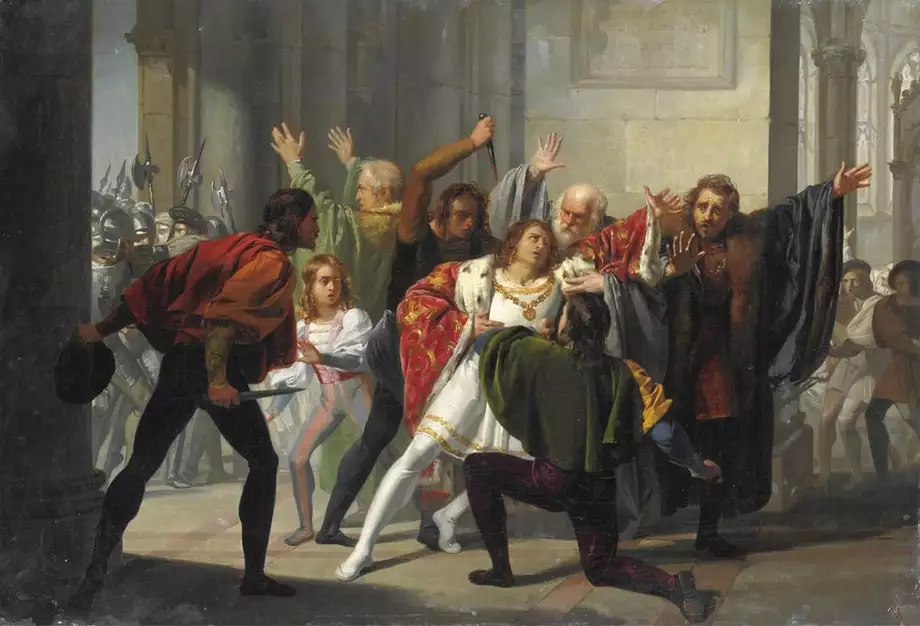
The circumstances of the assassination of Lorenzo de' Medici, in light of Leonardo da Vinci's sodomy charge, make it clear that nothing was sacred to the Medicis' political opponents. They waged their struggle ruthlessly
Leonardo wore pink clothes
The anonymous biographer Anonimo Magliabechiano, who is often equated with Vasari because of the easily confused style, mentions in his biography of Michelangelo a meeting between Leonardo and Michelangelo: "He [Leonardo] wore a rose-colored robe, short to the knee, although long dresses were worn at that time."
This description by Anonimo Magliabechiano contributes much today to the notion that Leonardo, in a sense conforming to the stereotype of the eccentric, openly homosexual, modern gay man, preferred to portray himself in pink clothing. The fact that Leonardo, according to the fashion of the time, also wore skirt-like clothing as a man reinforces this association.
Pink was not always a gay color
Today's color coding of the sexes cannot be applied to the Renaissance. The assignment of pink as a girl's color and blue as a boy's color is a newfangled one that has only been in effect since about the 19th century (see Marco Del Giudice; Pink, Blue, and Gender). Before that, there was no assignment of colors to gender, which can be readily seen in older paintings before the 19th century.
So even if Leonardo always wore pink clothing, it would be insignificant in terms of his sexuality at the time. At the time of the Renaissance, pink was not a girl's color and would not have had a gay meaning if worn by a man.
Leonardo took only boys as pupils
The fact that Leonardo always surrounded himself with young men is also understood as an indication of Leonardo's homosexuality.
Women were not allowed to become painters
The painter's workshops were male dominated, as women were not allowed to start training as painters until modern times. The fact that Leonardo had exclusively male students can therefore not be explained by a sexual inclination.
Training as a painter began at a young age
There were no public schools at the time of the Renaissance. The children and young people who wanted to enjoy the privilege of education, and did not have rich parents, were therefore dependent on the training companies and the knowledge of their masters. The typical age for an apprenticeship was 10-15 years. Leonardo himself had begun his apprenticeship between the ages of 12 and 14. This explains why there were also underage students in Leonardo's workshop.
Why Leonardo took in pupils
The painter Leonardo da Vinci did not work alone, but like all famous artists of his time, he was the head of a large craft workshop. The painter's workshop included hired servants, maids and assistants. The fact that Leonardo took on pupils also brought him numerous advantages.
- Posthumous fame
The master passed on his knowledge to his pupils, who then revered him. The painter thus increased his fame and had an influence on future developments - Financial reasons
The head of the painter's workshop usually received an apprenticeship fee and was thus financially secure. This could be a profitable business if the children of rich patrons were taken care of - Political reasons
The political network that was created by taking in students should not be underestimated. For example, Leonardo's pupil Francesco Melzi came from a very wealthy noble Milanese family. When Leonardo lost his employer Ludovico Sforza in the turmoil of the conquest of Milan by the French, he was able to live for a time on the Melzis' estate - Practical reasons
Students were able to do monotonous auxiliary work, such as priming canvases or running errands, etc. - Human reasons
Sympathy certainly played a role in the acceptance of students. It can be assumed that long-lasting friendships developed from this. At least two of his students, Salai and Francesco Melzi accompanied Leonardo until his death.
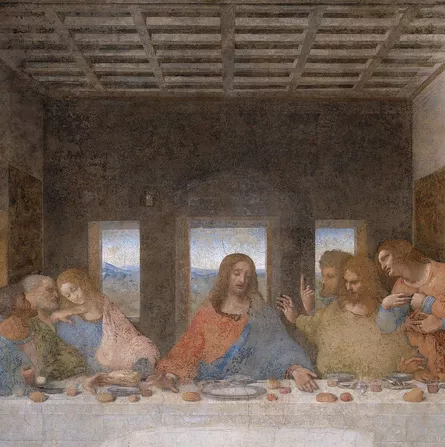
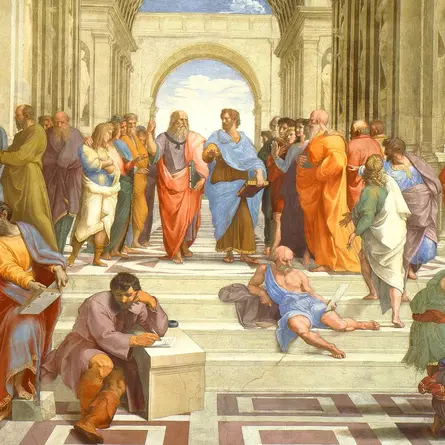
Leonardo preferred male nude models
The majority of Leonardo's nude drawings show men. The few female nude drawings mostly bear male features.
The church and nudity
This can be explained by the fact that according to the ecclesiastical understanding of the time, the depiction of nudity was not virtuous. If a painter wanted to show naked people without arousing the suspicion of the church, this was only permitted for a few religious motifs, such as Adam and Eve in Paradise, Jesus as a baby in the arms of the Madonna, or Jesus on the cross.
Lack of nude models
In order to be able to paint people after nature for practice, nude drawings of models were secretly made in the artists' workshops. This only applied to the better workshops; the worse ones were content to use antique statues or other paintings as models. Leonardo criticized this because it meant that their mistakes would also be copied.
For understandable reasons, it was difficult to find nude models without falling into a certain reputation. If it did not succeed, the always male students of the workshops took each other as models. This was then due to necessity and not necessarily an erotic preference.
The parodies
The lack of female models then explains drawings of men with breasts, which parody the amusing process of creation. In addition, it was common, especially in Italy, to verbalize the work of colleagues by sexualizing it. A work that was not liked, for example, was painted over with an erect penis or the like.
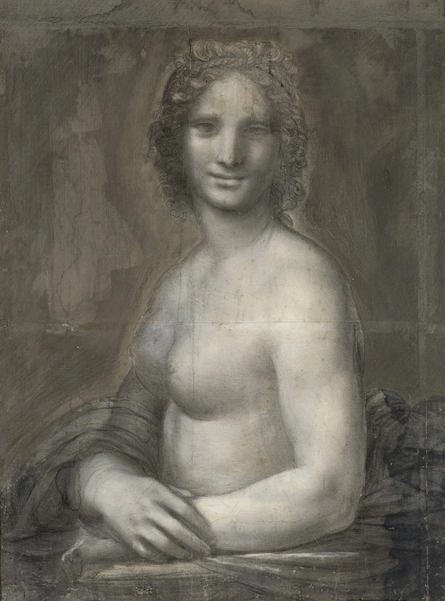
Armrest, cover and posture imitate Leonardo's Mona Lisa. The author probably recognized the imperfection of his work already in the making and alienated it parodistically
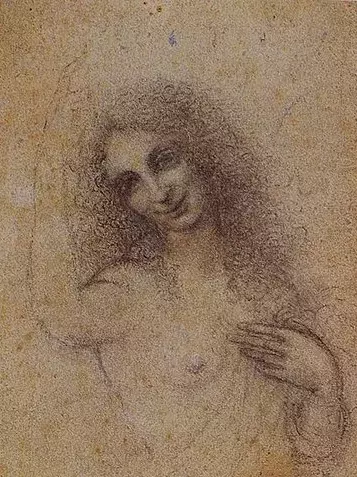
Imitation of Leonardo's John the Baptist, again the copy is not well done. The figure consequently gets painted breasts and an erect penis
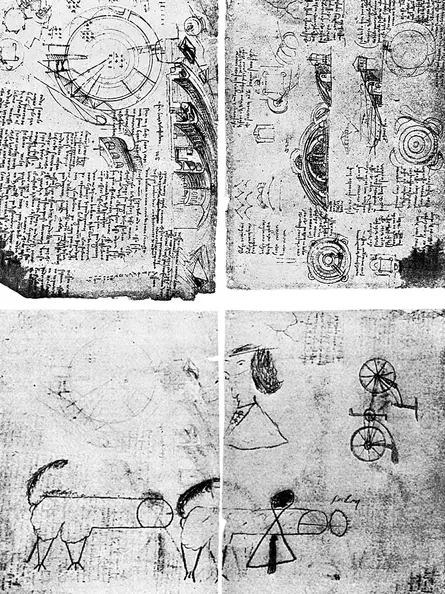
Below two phallus representations, the one on the right with the inscription Salai. To the right a drawing of a bicycle added in the 1970s, which surprisingly was long thought to be genuine. The lower representations differ stylistically considerably from Leonardo's upper drawing
Leonardo had a gay marriage with Salai
This is the thesis: Leonardo is said to have taken in the handsome 10-year-old Salai out of a homoerotic need when he was 38 years old. When Salai then grew older, Leonardo, contrary to expectations, did not turn away from him, although Salai was grown-up, cocky and untalented and, moreover, also stole from him. Nevertheless, Leonardo loved Salai and lived with him in a marriage-like relationship. When Leonardo died, he left Salai the house they shared in Milan. Salai did not overcome Leonardo's death and died five years later in a violent confrontation.
Who was Salai?
Salai (Arabic/Italic 'little devil, imp') was the call name of Gian Giacomo Caprotti, given to him by Leonardo when he was about 14 years old. He was born around 1480 in Oreno near Monza. Little is known about Salai's family. He was the son of Pietro and a Caterina, who happened to have the same first name as Leonardo's mother. Leonardo biographer Charles Nicholl suggests, based on the designation of Salai's father in a legal document, as "Pietro, son of the late Lord John," that Salai's grandfather must have owned some land and status. In any case, Pietro was willing to pay Leonardo to take Salai in and therefore must have possessed some money. In addition, Salai had two sisters.
According to Vasari, Leonardo is said to have taken Salai as a pupil in 1490 while he was still a boy: "During his stay in Milan, Leonardo took a youth of that city, Salai, as his pupil". Leonardo himself notes: "Jacomo [Giacomo] came to my house on Magdalen's Day [July 22] 1490, 10 years old".
Exactly what tasks Salai took on in the workshop is not known. It is conceivable that he was initially employed as a servant, errand boy and model. Certainly, there was also an apprenticeship as a painter. There are documents that prove important errands of Salai, e.g. for Leonardo's correspondence with Isabelle d'Este. Salai's work as a painter, however, is considered insignificant. It is assumed that the "Monna Vanna" was his work (above), in general no painting can be proven beyond doubt.
Salai died a violent death in 1524, five years after Leonardo's death. The reason for the quarrel is unknown. Salai was married to a Bianca de Anono, as is known from the letter of the notary Crevenna dated 01.04.1525. The latter mediated in an inheritance dispute between Salai's wife and his two sisters and drew up a list of Salai's estate on that day. Salai lived only 44 years and left no descendants.
Salai, the thief
Salai's character was initially considered rebellious. In July 1491, about 1 1/2 years after Salai had joined his workshop, Leonardo made a famous note of the financial damage Salai had caused him. Presumably he intended to have Salai's father reimburse him for the amount. Some authors, including Charles Nicholl, incomprehensibly read a homoerotic-tender undertone out of Leonardo's accusation:
"The second day after, I had him cut two shirts, a pair of trousers, and a doublet, and when I put aside the money for these things, he stole this money out of my pocket, and I never succeeded in getting him to confess, though I was firmly convinced that he would. (4 lire)
The following day I went to a dinner at Giacomo Andrea's, and the said Giacomo meanwhile ate for two and did damage for four. For he broke three jugs, spilled the wine, and after that he went to dinner with me, where I [sentence unfinished].
Further: on September 7, he stole a stylus worth 22 soldi, which was made of silver, from Marco, who was staying with me, and stole it from his workshop. After searching for it for a long time, the said Marco found it hidden in the chest of the said Giacomo. (1 lira)
On the 26th of January of the following year, while staying in the house of Messer Galeazzo da Sanseverino to prepare his tournament feast, and when some pages were undressing to try on some dresses of savages who were performing at this feast, Giacomo approached the purse of one of them, which was lying on the bed with other dresses, and took out the money he found in it. (2 lire, 4 soldi)
Also: having received from Master Agostino of Pavia in the said house a gift of Turkish leather for a pair of boots, Giacomo stole it from me during the month and sold it to a cobbler for 20 soldi, whereupon, as he himself confessed to me, he bought anise cake with the money. (2 lire)
On April 2, when Gian Antonio left a silver stylus on one of his drawings, this Giacomo stole the stylus from him, which was worth 24 soldi. (1 lira, 4 soldi)"
Leonardo summarizes Salai's character at the time in a marginal note to the inventory in four words, "thievish, mendacious, defiant, gluttonous." The damage done to Leonardo by the inclusion of Salai was therefore more than 10 lire and 8 soldi. In today's currency this corresponds to an amount of more than 4000,- Euro (The conversion is explained in the article "Leonardo's finances"). Salai's thieving behavior probably lasted for several years, because even six years later Leonardo noted in a renewed list of maintenance costs on 4.4.1497: "Salai steals money". But he seems to have finally forgiven him for his behavior, since Salai stayed with him until shortly before Leonardo's death.
Leonardo's generosity
In addition to the above costs, Leonardo claims another 32 lira in expenses (about 13,000 euros) spent on Salai's other clothing, including 24 pairs of shoes. This expense must be seen in context. Leonardo was a member of the court of Milan, and he could not send his messengers to the duke in poor threads. Moreover, Leonardo was known to dress only in fine fabrics, and to outfit the members of his workshop likewise. So he did not only dress Salai in the same way. It is unclear to what extent Salai's father was informed in advance of these additional costs, and whether he ever paid them.
Leonardo's life with Salai
There are no documents that suggest an intimate personal relationship between the two. The fact that Leonardo took the ten-year-old boy to himself can be explained by social responsibility, teaching zeal or compassion for the living conditions of the boy, who had presumably been living in poverty until then. It is not unusual that Salai remained Leonardo's pupil until his death, because Francesco Melzi also stayed with him until then. The noble Melzi from the most distinguished circles of Milan had also become Leonardo's pupil as a boy.
Salai was not an outstanding painter and it would certainly have been difficult for him to make a living in an environment of strong competition. Thus, Salai may have had no choice but to continue in Leonardo's service. But to understand this collaboration in Leonardo's workshop as a marriage-like community and to give it a sexual component seems arbitrary. At least this is not provable.
Leonardo's will - The generous gift to Salai
The allegedly amorous relationship of Leonardo and Salai is supposed to prove a generous gift that was determined in Leonardo's will. If the complete will is read, it becomes clearer that Leonardo did not grant Salai a generous inheritance. He gave him the same thing that he gave to his servant Vilanis. The main part of the fortune went to Melzi and Leonardo's siblings. From this it is probably easier to deduce the relationship between Leonardo and Salai.
"[Leonardo da Vinci] bequeaths [...] to his servant Battista de Vilanis for ever and ever half, viz. half of the garden which he owns outside the gates of Milan, and the other half of the same garden to his servant Salai; in which garden the said Salai has erected and built a house, which shall also belong and remain forever to the said Salai, his heirs and successors, as compensation for the good and welcome services rendered him by his servants, the said de Vilanis and Salai, henceforth and forever."
The "Garden at the Gates of Milan" was a gift from the Duke of Milan to Leonardo (1497), two years before his fall at the hands of the French. It is significant that both Vilanis and Salai inherit the Milanese property equally, and both are referred to as servants. The "good and welcome services" are interpreted by many authors as Salai's sexual favors. This often omits the context of the longstanding servant relationship, both to Salai and to Vilanis. The "good and welcome services" are then nothing more than a phrase of courtesy, addressed to both Vilanis and Salai, in the context of a generous gift and devoid of any sexual component.
Nonetheless, Salai's decades-long allegiance gave him a special position, as he owned several valuable paintings that are valued comparatively highly in the aforementioned lawsuit after his death. It is believed that some of Leonardo's originals were involved. Among others, the Mona Lisa is said to have been in his possession ("1 painting, woman moved backwards, called La Joconda, 100 scudo", notarial acts of Pietro Paolo Crevenna: Salai's estate).
The Mona Lisa as a portrait of Salai
It is often read that the man Salai could have been the model for the female portrait "Mona Lisa". An indication of this is said to be the name Mona Lisa, which is an anagram of "Mon Salai" (French for "My Salai"). However, Leonardo never named the painting in this way, the first to call the work Mona Lisa is Giorgio Vasari. In Leonardo's environment, the portrait was probably called Gioconda.
Besides "Mon Salai" also "Nom Alias" (French 'alias name') and "Mon Alias" (French 'My Alias') are meaningful anagrams to Mona Lisa. Then Leonardo would have meant himself. And that's only if it is assumed that Mona Lisa does not show Mon(n)a Lisa del Giocondo.
Other portraits and drawings by Salai
It is also claimed that Salai was the model for "John the Baptist". Anyone who recognizes a similarity in the face of the Mona Lisa and John the Baptist may believe that Salai modeled for both paintings. What complicates the matter is the fact that to this day it is unclear what Salai looked like at all.
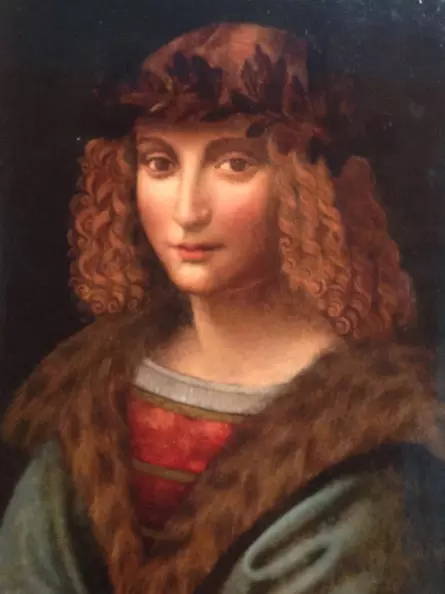
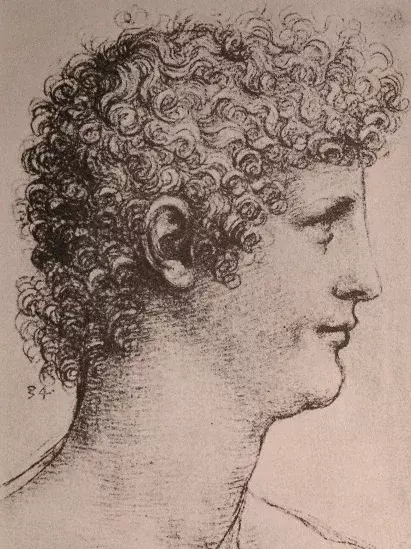
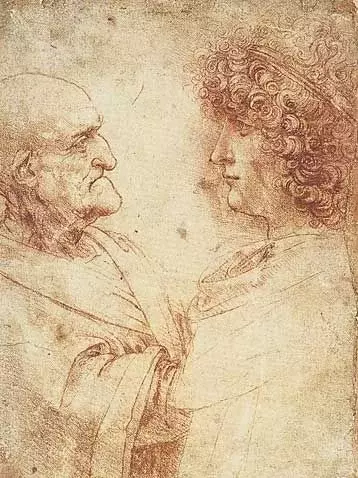
Giorgio Vasari: Leonardo found great pleasure in Salai
Giorgio Vasari - The first art historian
Vasari's biographies of artists are today considered the birth of art history. For the Renaissance era, his work was the standard work for a long time and is still the most cited today. So is Vasari's biography of Leonardo. It appeared in two editions, a first one from 1550 and a second one with expanded content from 1568, several decades after Leonardo's death (1519). Vasari himself was only eight years old when Leonardo died.
Vasari belonged to the direct circle of friends of the well-known Italian noble family Medici. He had grown up with some descendants of the family and later became an important painter and architect in Florence. Thus, from 1555, he was responsible for the reconstruction of the city parliament of Florence (Palazzo Vecchio), during which he painted over or bricked up the unfinished mural "Battle of Anghiari" begun by Leonardo. The painting has since been considered lost. Vasari was also the chief architect of the Florentine Uffizi. Due to his, as well as Leonardo's close connection to the Medici, it can be assumed that his statements regarding Leonardo da Vinci must be particularly credible. Nevertheless, some of his statements are now considered refuted.
A piquant formulation in Leonardo's biography
Giorgio Vasari reports in his Leonardo biography of 1550 about the boy Salai (* around 1480), whom Leonardo took in around 1490 and in whom he found a "strange pleasure". In a second later version of 1568, Vasari rephrased the passage:
"During his stay in Milan, Leonardo took as his pupil a youth of that city, Salai. Leonardo took great delight in the latter's grace and beauty, especially in his curly hair. He taught him many things in art, and some paintings attributed to Salai in Milan are reworked by Leonardo."
It takes some daring to conclude Leonardo's homosexual tendencies based on this statement. Vasari mentions Salai only briefly with these sentences. In this respect, they are not suitable as proof of Leonardo's homosexuality. Nevertheless, the formulation can be found in this context again and again "... as already Vasari stated ..." or similar. Vasari's centuries-long influence on the art-historical image of Leonardo da Vinci cannot be overestimated.
Lomazzo: Leonardo did it with Salai
Like Vasari, Lomazzo is also frequently cited when discussing Leonardo's assumed homosexuality. Lomazzo's book "Scritti sulle arti" contains, with the fragmentarily preserved "Gli Sogni e Raggionamenti," various dialogues that were presumably conceived as plays. In one of these fictional dialogues, he has Leonardo and the ancient sculptor Phidias talk about male love ('L'Amore Masculino'). In it, Phidias asked the fictional Leonardo if he had made love to his pupil Salai and has him reply, "all too often." Although this is a fictional work, Lomazzo is cited as a historical source when proving Leonardo's homosexuality.
Who was Lomazzo?
Giovanni Paolo Lomazzo (1538-1600) was an extremely talented painter in the style of Caravaggio. He came into contact with Franceso Melzi, and probably had him tell him about Leonardo. Melzi was Leonardo's last pupil, his executor and in possession of all Leonardo's notebooks. The painter Lomazzo could no longer benefit from the knowledge thus acquired, for he went blind at the age of about 30, around the time Melzi died (1570). He gave up painting and has since emerged as an art theorist.
Excerpt of the fictitious dialogue between Leonardo and Phidias
"Leonardo: [...] Salai, whom I loved more than anyone else all my life, and there were quite a few of them.
Phidias: Are you making love to him perhaps? What the Florentines like so much, playing from behind?
Leonardo: All too often! Remember, he was a beautiful boy, especially at fifteen.
Phidias: Aren't you ashamed to say that?
Leonardo: Why ashamed? Nothing is more worthy of praise among the virtuous than this. And that this is true I will prove to you with good reasons".
That it was in Lomazzo's intention to defame Leonardo is well seen in the last line of the quotation. Leonardo often used phrases of the type 'as I have proved with good reasons' or similar in his scientific notes. That Lomazzo adopts this choice of words to have Leonardo 'prove with good reasons' that in terms of virtue nothing is more to be praised than pederasty greatly increases the mock value of the work. But at the same time it makes clear the clearly defamatory character of this persiflage.
That this fictional literary mockery cannot be sufficient as evidence of Leonardo's homosexuality goes without saying. Since Leonardo already died in 1519, Lomazzo, who was born in 1538, can only have passed on hearsay. Advocates of Leonardo's homosexuality argue that he learned this from Melzi.
Whether Melzi, who revered Leonardo and wanted to preserve his memory, would have actually given Lomazzo such information is doubtful. Homosexuality was considered a serious offense at the time, could even be punished by death, and would have led to Leonardo's ostracism even beyond death.
A populist success
Many art historians subsequently adopted the narrative of a homosexual Leonardo. Even one of the best-known current Leonardo experts, Frank Zöllner, with reference to Lomazzo, insinuates Leonardo's homosexual tendencies "as an almost self-evident part of his genius". Directly in the 4th sentence of his widely distributed book from the Taschen publishing house. The matter-of-factness with which here a world-renowned art historian justifies the thesis of Leonardo's homosexuality with a fictional narrative is surprising.
Overall, this process is a good example of how fictitious narratives can assert themselves as truth, if they are only
- they are repeated often enough by supposed experts
- the audience has no prior knowledge and has to rely or wants to rely on narratives of others
Lomazzo's contemporaries could not look at Leonardo's paintings in the museum, nor did they have access to his writings. These were all privately owned by a few. For lack of reliable statements, they therefore had to believe what they were told about Leonardo by third parties, here by Lomazzo. What intention the blind painter Lomazzo pursued with his popular literary work is unclear today.
Sigmund Freud: Leonardo was passively homosexual
In 1910, Sigmund Freud dealt with Leonardo's sexuality in particular and that of geniuses in general as part of the psychoanalysis he developed. However, his work "A Childhood Memory of Leonardo da Vinci" does not satisfy any scientific claim, since he cannot cite any sources for his assertion that Leonardo was a passive homosexual. Surprisingly, he also states this at the beginning. And so the derivation of his theory is then based merely on mutually dependent assumptions.
Symbolically, he then also commits a momentous translation error by mistakenly translating the Italian "nibio" as "vulture" instead of "Milan". The following argumentation of a motherly love, which leads back to the mythology of Aegypt, where the vulture was a symbol of motherliness, consequently leads to nothing.
Freud's work on Leonardo is in itself little more than an attempt to popularize psychoanalysis in a popular scientific way. A scientific proof of Leonardo da Vinci's homosexuality necessarily does not succeed for lack of reliable sources.
Was Leonardo gay or not?
How Leonardo da Vinci really felt in his deepest heart can probably not be determined more than 500 years after his death. However, the question can be approached by examining all the points raised by the proponents of Leonardo's homosexuality. And as has been shown, there is no compelling evidence that Leonardo da Vinci was homosexual.
In fact, the opposite can be established: All claims that are supposed to support Leonardo's homosexuality are, upon closer examination, misinterpretations (pink dresses) or intentionally scattered misinformation (Lomazzo). Regarding Leonardo's homosexuality, the impression of a disinformation campaign remains. About its reasons can only be speculated.
Leonardo's sexuality
Independently of the search for evidence of Leonardo's alleged homosexuality, the question of Leonardo's sexuality in general can be raised. Even though this is rarely addressed apart from Leonardo's assumed homosexuality, he did comment on it in his writings.
Four quotations will now be mentioned, which firstly show Leonardo as someone who was disgusted by sex, and from this must have been an asexual person. Second, another of Leonardo's quotes can be understood to mean that he had incestuous feelings for his mother and sisters. A third may show Leonardo as the victim of homosexual child abuse, which may have been the cause of later homosexual tendencies. And finally, a brief note in the Codex Atlanticus may be interpreted to show that Leonardo had a clandestine affair with Cecilia Gallerani, the "lady with the ermine" and brief mistress of his longtime employer Ludovico Sforza.
Now everything cannot be right at the same time. Leonardo could not have loved asexually, heterosexually, incestuously or homosexually at the same moment. These four quotations are meant to demonstrate that Leonardo's thoughts were marked by contradictions and that he thought in so many different ways that it seems presumptuous today to make reliable statements about his sexual life. At least as long as Leonardo's own statements, as well as the few secured biographical facts, leave too much room for interpretation.
The act of procreation and the limbs used for it are so disgusting that, were it not for the beauty of the faces and the adornment of the doers and the instinct inherent in us, nature would lose us human beings.
The asexual Leonardo
A good example of the difficulty of statements about Leonardo's sexuality, is this Leonardo quote from the Codex Windsor. Some authors deduce from it that Leonardo considered sex as something disgusting.
Others understand the quote in the context of an anatomical study. The quote is on a sheet with anatomical drawings of hands. The drawing, and thus the quotation, were thus made during or shortly after the dissection of a corpse. At that moment, disgust and beauty must have been close together, which must have been the mental background of the quotation. In addition, it is a fundamental trait of Leonardo to be amused by the contradictions of life in all its facets.
Leonardo's writings are, as here, often only snapshots of his thinking and reflect only fleeting thoughts where they should not be published. Also, often the sheets are rarely in their original order, leaving the context of their wording unclear. And finally, the sheets were eagerly falsified, which also makes final statements difficult here. Thus, it is hardly possible to deduce Leonardo's complete world of thought from the loose quotations and individual sheets.
To men it will seem as if something will fall from the sky again, and it will seem to them as if they will rise up in it for flight and flee from it for fear of the flames that will come down from it, they will hear the animals speaking in every kind of human language, they will immediately reach different parts of the world with their bodies without moving, they will see a great glow in the darkness. O amazement of the human race! What madness has led you thus? You will speak with the animals of every species, and they with you, in the language of men, you will see yourself falling from great heights without hurting yourself, torrential rivers will accompany you and incorporate you into their rapid course, you will have carnal intercourse with your mother and your sisters [illegible] you will have feathers with the animals [illegible].
The incestuous Leonardo
Leonardo left numerous prophecies, which are only at first sight "prophecy", as he himself titled them. Rather, they were riddles to be recited on ceremonial occasions for the entertainment of guests. Leonardo suggests that the "prophecies" be recited in a crazed voice, presumably this was to increase the entertainment value. The riddles were often exaggerated into the fantastic and were intended to cause the greatest astonishment when they were solved. They were entertaining fun, arising from the ambiguity in the description of things when details are omitted. There are over 100 of these riddles extant, here are more examples.
"The waters of the sea will rise above the tops of the mountains and fall from the sky upon the houses of men." - Clouds and rain
Or
"(Say it hastily or as if you were crazy) Many will be busy taking away from that which grows the more you take away." - Pit
It seems that I was destined to deal so thoroughly with the kite before, because it comes to my mind as a very early memory that when I was still in the cradle, a kite descended to me, opened my mouth with its tail and many times pushed its tail against my lips with it.
The abused Leonardo
This sentence is one of the most famous personal sentences of Leonardo. The famous psychoanalyst Sigmund Freud certainly contributed the most to its dissemination. He was fascinated by Leonardo da Vinci and dedicated the scientific essay "A childhood memory of Leonardo da Vinci" to him. Leonardo's childhood memory, and thus the hook of his essay, is precisely that Leonardo quote. Freud gets to the point without a long preface and gives the quotation a sexual note, believing the Milan's tail to be a phallic symbol, because it "corresponds to the idea of fellatio, a sexual act in which the member is inserted into the mouth of the used person."
Freud qualifies the statement later in the text when it becomes clearer that he is merely misusing Leonardo as a vehicle for his method of psychoanalysis, but the damage has already been done. Less psychologically trained Leonardo biographers like Charles Nicholl are tempted to paint their own unique picture of Leonardo's childhood with Freud's sentences behind them. Niccholl speaks, without citing evidence, of Leonardo not having grown up with his grandparents, as is evident from tax records. Instead, he constructs the theory that Leonardo grew up with his stepfather. The latter is said to have been extremely violent, which he establishes by a court record that names him as a witness to a brawl, and finally he implies that this stereotype of the violent stepfather also abused Leonardo sexually, which is said to have led Leonardo to the above admission of his abuse, admittedly in a way that corresponds to his literary genius.
Both, Freud and Niccholl, consider it completely impossible that the scene could have actually taken place as Leonardo describes it. Moreover, both think that they are able to create a psychogram from such a short text of a genius. Significantly, Freud states several times that he could not succeed in doing so because too much about Leonardo's life is unclear.
Madonna Cecilia, my dearly beloved goddess, I have read your sweet letter
The Leonardo of the ladies of the court
A short line in the Codex Atlanticus leads to the assumption that Leonardo had a secret affair with Cecilia Gallerani. Cecilia was for some years the mistress of the Duke of Milan, for whom Leonardo worked for almost 20 years. Cecilia became pregnant by the Duke when she was 16 years old. During this time she portrayed Leonardo as a lady with an ermine. When the Duke married Beatrice d'Este shortly thereafter, Cecilia was banished from court, but continued to reside in Milan. She was extremely culturally educated, endowed by the duke with lands and riches, and became an extremely well-connected lady of society and patron of the arts in northern Italy. It is conceivable, but not historically proven, that Leonardo da Vinci was in close contact with her, or even had a secret relationship with her. Certainly such an affair would have had to remain secret, because the Milanese Duke Ludovico Sforza, Leonardo's employer and father of Cecilia's son, would certainly have been very displeased, since he had appointed her a more befitting companion in Count Bergamini. Because of his work as a painter and engineer, Leonardo da Vinci, despite his acknowledged genius, was regarded among the ranks of the high nobility only as an admirable craftsman, but he was by no means equal to the nobility in status.
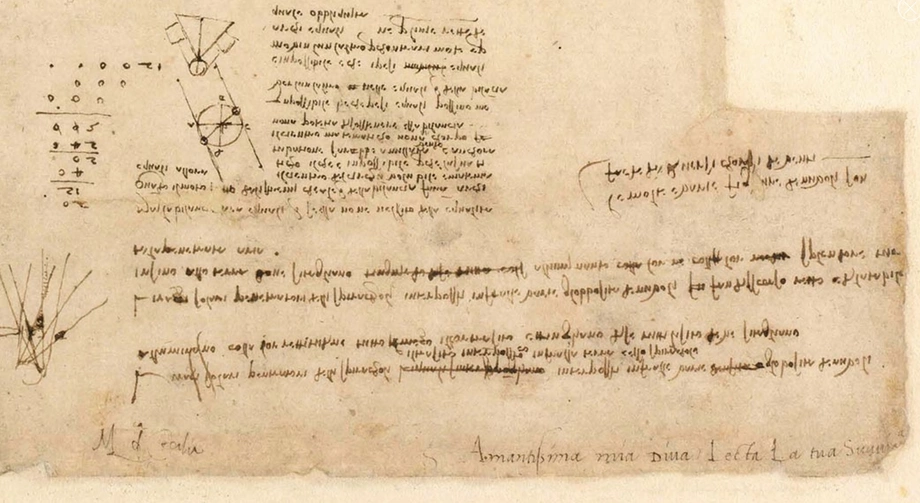
It is not unusual for Leonardo to make full use of the free space on the sheets, because paper was relatively expensive at the time. The one line addressed to Cecilia Gallerani at the top of the sheet can only be read when the sheet is turned upside down, as it is here. The line at the bottom is not written in mirror writing. Leonardo rarely wrote in normal writing direction. Accordingly, the result is a different typeface. Compared to other texts by Leonardo with normal writing direction, however, this line to Cecilia is less filigree and could therefore have been added by a second person afterwards
Final conclusion
Leonardo's portrait of the Mona Lisa is the most famous painting in the history of mankind. There is hardly a schoolchild who has not heard of the universal genius of the Renaissance. Leonardo is always described as elegant, well-groomed, clever, entertaining and influential. All the more surprising is the fact that he remained unmarried and died childless.
The most obvious explanation then seems to be that he must have been gay, because only gays do not marry and die childless. Leonardo's life is then reinterpreted in this direction. He did not surround himself with young men because he ran a painter's workshop and needed talented employees, no, they were love objects for him. He did not wear pink dresses out of a personal taste, they were a homosexual confession.
Leonardo's lifelong attachment to the bourgeois, enlightened Medici family made him a target of their enemies, and there were plenty of those. Leonardo was subsequently accused of sodomy and, like all Florentines, maliciously slandered as a homosexual. Fittingly, a mocking stage play was written by the poet Lomazzo that exposed Leonardo to ridicule for centuries to come. The propagandistic fairy tale of the homosexual Leonardo from the frowned-upon free-spirited Florence is handed down by art historians to the present day, presumably because it fits in well with the times.
For an increasingly self-aware LGBTQ movement is looking for its heroes and its own historical narrative. What could be greater than to know a Leonardo da Vinci as a "clamp sister" (queer.de) in their own ranks. That then also a Sigmund Freud, the highest authority of psychoanalysis, certifies Leonardo the passive homosexuality is then no longer questioned, but simply taken as a fact.
What is left to say then but: "Yes, I heard that too. Leonardo was gay".
What really remains is the statement that no statements can be made about Leonardo's sex life, because there are no reliable sources about Leonardo's sex life. The fact that no love affairs with women are known does not mean that Leonardo was gay or asexual. It only means that no love affairs with women are known. It seems to be in the human nature not to be able to accept the state of uncertainty and to want to take over every explanation only for its own sake. And if necessary to help the own truth a little bit.
And God said, This is the sign of the covenant which I establish between me and you and the living creatures with you for all generations to come.
My bow I will set in the clouds. It shall become the sign of the covenant between me and the earth.
If I gather clouds over the earth and the bow appears in the clouds, then I remember the covenant that exists between me and you and all living beings, all beings of flesh, and the water will never again become a flood that corrupts all beings of flesh.
When the bow is in the clouds, I will look upon it and remember the everlasting covenant between God and all living creatures, all creatures of flesh on the earth.
And God said to Noah, "This is the sign of the covenant I have established between me and all beings of flesh on the earth.
![[Translate to english:] [Translate to english:]](/fileadmin/_processed_/1/2/csm_war-leonardo-da-vinci-schwul_a9e87de2ac.webp.pagespeed.ce.Xfoat2MAgW.webp)
![[Translate to english:] [Translate to english:]](/fileadmin/_processed_/8/b/csm_leonardo-alle-gemaelde_2dc4b01ef6.webp.pagespeed.ce.ohfmgl8OfF.webp)
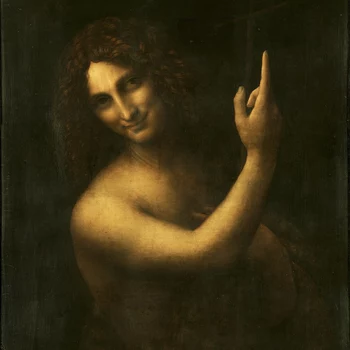
![[Translate to english:] [Translate to english:]](/fileadmin/_processed_/7/0/csm_anna-selbdritt_370c8646a0.webp.pagespeed.ce.NuSK1feNeY.webp)
![[Translate to english:] [Translate to english:]](/fileadmin/_processed_/2/8/csm_sigmund-freud-kindheitserinnerung-des-leonardo-da-vinci_413da547be.webp.pagespeed.ce.6JdSEa4Rkx.webp)